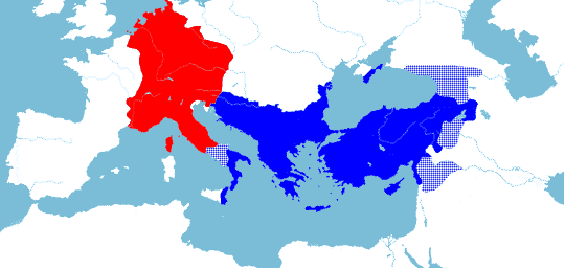When the Roman Empire dissolved into Eastern and Western entities, the East became the Byzantine Empire while the West forged a new identity tied to the Latin Church.
The disintegration of the Roman Empire began in earnest during the 3rd Century. As frontiers along the Rhine River began to crumble, barbarians from the Germanic regions began to cross into Roman territory. Poor imperial leadership, often resulting in civil war between competing would-be emperors, contributed to the growing weakness.
Although many of the early barbarian groups had no specific desire to conquer Rome, they were enticed by Roman civilization and prosperity while frequently fleeing other barbarian groups moving into Central Europe from the east. By the 4th Century, following the reign of Constantine the Great, the last emperor to rule over a unified Rome, the division between east and west was complete.
East vs West in Latter Imperial Times
The Eastern Empire was vastly different from the West. The East contained the largest population centers and the wealthiest cities. The moving of the capital to Constantinople by Constantine added the element of prestige and signified the importance of the East. Dominated by ancient civilizations that predated Rome, the East was far more eclectic and open to competing philosophies and religious ideals. The Christian population in the East, for example, was substantially higher than in the West.
The West was more prone to barbarian incursions as Germanic tribes invaded Gaul and eventually Italy during the 5th Century. Western legions were often composed of barbarian recruits, men that had no loyalty to Rome nor shared common interests related to imperial goals. As civil government crumbled, the Catholic Church emerged as both civil and spiritual leader under the auspices of local bishops whose seats coincided with the Roman civitates.
Although the Byzantine Emperor Justinian attempted to reunify the empire in the 6th Century, barbarian groups like the Lombards, Allemani, Vandals, and Franks continued to separate the West from the East. This separation resulted in the remnants of the Western Empire transforming into a new civilization independent of the rise of the Eastern Byzantine Empire.
Religion, Law, and Culture
Western European civilization has been defined as the product of Roman culture, the Christian Church, and barbarian culture and traditions. In the West, Latin Christianity dominated religious tradition while in the East, Orthodoxy emerged as the primary religious faith tradition. The East refused to acknowledge the Roman pope or pontiff as the supreme head of the Christian Church, vesting authority instead in the Patriarch of Constantinople who was appointed by the emperor.
The East continued to practice Roman law, codified in the 6th Century by Justinian. This code would not be reintroduced in the West until the 11th and 12 Centuries. Western law was an amalgamation of pagan Germanic law, based on the Wergeld model, and Canon Law. With a liberal dose of superstition, such as trial by water and compurgation, post-Roman western law lost the Roman element of due process.
Which Empire Ultimately Survived?
Despite clear advantages connected to Imperial Rome, the Byzantine Empire, although lasting until 1453, disintegrated rapidly. By the 11th Century, Byzantine emperors frantically requested military assistance from the West to contain Muslim advances, notably after the battle of Manzikert in 1071. By 1453, only Constantinople remained.
In the West, however, Muslim attempts to conquer were repelled decisively such as at Tours in 732 by Charles Martel. In many ways, the cohesiveness of the Roman Empire was replaced by the Catholic Church which was forced to forge alliances with strong secular rulers like Charlemagne. While the East struggled, the West was transformed. It can be argued that, at least on one level, the fate of East and West was intimately tied to religion and the role of Christianity, a fact acknowledged by Eastern emperors soliciting western military support via the Medieval papacy.








